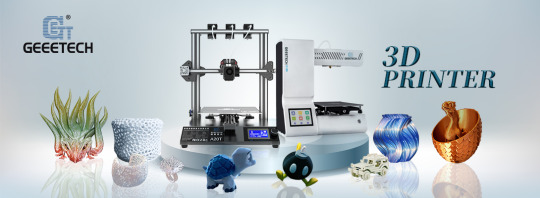#3dprinttechnology
Photo

For all your 3D printing and consultancy needs please visit our SAMC website or DM me. Link in the bio. . . . . . #craftinicreativelounge #3dprint #3dprinting #3d #largescale3dprinter #big3dprinter #3dmodeling #3dprinter #industrial3dprinting #3dprinttechnology (at Pune, Maharashtra) https://www.instagram.com/p/CCN1320nu_H/?igshid=1v0lr9ip9atbx
#craftinicreativelounge#3dprint#3dprinting#3d#largescale3dprinter#big3dprinter#3dmodeling#3dprinter#industrial3dprinting#3dprinttechnology
0 notes
Photo

Tips on how to improve your print quality
3D printing can present all sorts of problems.Whether you are a newbie or expert, chances are you are constantly tweaking a bit here and a bit there just to get the desired results.There are, however, a number of things you can do to get around some common issues in 3D printing and improve your print quality. Good news is that you do not have to be an expert to get started.
Assembly & Set Up
Set up your 3D printer as per the instructions. No matter how experienced you are,your vendor supposedly knows the products better than you do. It is recommended that you use parts, software,and materials from the same brand wherever you can to get the best experience. Remember, every 3D printer has its own characteristics. Be open to some trial and error down the road.
Software Update
Keep your system up to date. Manufacturers and slicer companies are constantly experimenting with their software and firmware to fix bugs and improve performance. If your machine features an automatic update, enable it.
Maintenance
Perform regular maintenance and calibration on your 3D printer:form and maintain a routine of checks;keep your filaments from moisture and dust; calibrate the bed.
Supports
Bear in mind the 45-degree rule and 5mm rule. Any overhangs of above 45 degrees(or 60 degrees depending on your printer) may require supports. Just like overhangs, not all bridges require supports.Consider supports only when the bridge is more than 5mm long. “Rafts” , “brims” are great support tools to increase adhesion.Add support structures to your design for any steep overhanging features or models that have a small base.
While supports are great for some cases,you may want to avoid them,for the following reasons:first, it consumes extra filament; second, the print takes longer time; and finally, removing the support structure off the print can be a pain. If you are still not sure whether you need supports, run a test print to find out. You can also use your creativity to make the support structures part of your design, in case you think them necessary. Ways to circumvent supports: reorient your model; reduce the overhang angles;split your model into smaller parts.
The first layer
Your first layer is the foremost important layer of your print. Make sure it sticks well to the bed. Again, supports can be great tools to help with adhesion. Use a heated bed or apply glue to prevent warping from happening.
Details
Examine the details of your model. Are there any tiny projections or parts that are too small to print on a desktop 3D printer? In your printer, there is a very important but often overlooked variable, that is the line width, which is determined by the diameter of the printer nozzle. And most printers come with a nozzle of 0.4 mm or 0.5 mm in the diameter.
This post is originally published on geeetech official blog
#3dprinter#desktop3dprinter#3dprinting#3d technology#3Ddesign#3d model#slicer#Geeetech#3Dprinttechnology
0 notes
Video
(vía https://www.youtube.com/watch?v=bjhlQK0W0Dc)
Adidas and Carbon Futurecraft 4D: Sneakers in 3D print technology.
Adidas has chosen a new process for creating the sole of these shoes, called Continuous Liquid Interface Production, basically what it does in it is to remove the piece from a liquid polymer...
#fashion #Adidas #Nike #shoes #Carbon3D #Makers #AdidasCarbonFuturecr4Daft #AdidasFuturecraft4D #technology #3DPrintTechnology #Innovation #Technology #Futurecraft4D
0 notes
Photo

ABCs of 3D Printing
Contents
What is 3D printing?
3D printing technologies
The history of 3D printing
3D printing applications
What is a 3D printer?
What are the differences between a basic rapid prototyping machine and a 3D printer?
What can you make with a 3D printer?
What materials are used to print 3D objects?
What 3D modeling software is suitable for a beginner in 3D design?
How long does it take for a newbie to get the hang of 3D modeling?
Where can I get 3D models?
What Is 3D Printing?
3D printing, also known as desktop fabrication or additive manufacturing,is a prototyping process whereby a real object is created from a 3D design. The digital 3D-model saved in STL format is sent to a 3D printer. The 3D printer then prints the design layer by layer and form a real object. Read more..
3D Printing Technologies
There are a number of technologies used in 3D printing, with the most widely used ones being SLS (selective laser sintering), FDM (fused deposition modeling) & SLA (stereolithograhpy) . Selective laser sintering (SLS) and fused deposition modeling (FDM) use melting or softening materials to produce the layers.
This video illustrates how laser-sintering process melts fine powders, bit by bit, into 3D shapes.
https://www.youtube.com/watch?v=wD9-QEo-qDk
This video shows how FDM works.
https://www.youtube.com/watch?v=SPtkOmP_HoA
The video below explains the process of Stereolithography (SLA).
https://www.youtube.com/watch?v=iceiNb_1E0I
History of 3D Printing
October 5, 2011 — Roland DG Corporation introduced the new iModela iM-01.
Sep, 2011 — Vienna University of Technology, a smaller, lighter and cheaper printing device developed.
This smallest 3D printer weighs 1.5 kilograms, costing around 1200 Euros.
Aug, 2011 — World’s first 3D printed aircraft by Engineers at the University of Southampton.
Read more.
3D Printing Applications
One of the most important applications of 3D printing is in the medical industry. With 3D printing, surgeons can produce mockups of parts of the patients’ body which needs to be operated upon.
3D printing makes it possible to produce an object from scratch in just a few hours.
Nowadays almost everything from aerospace components to toys are being built with the help of 3D printers. 3D printing is also used for jewelry and art, architecture, fashion design, architecture and interior design.
Here are some extraordinary examples of 3D-printing:
The World’s First 3D-Printed Car
https://www.youtube.com/watch?v=-rprfWfgnFc
World’s first chocolate printer
https://www.youtube.com/watch?v=BIFi8but3Vw
World’s first 3D printed bikini
https://www.youtube.com/watch?v=d2iT8S0m3m4
What is a 3D printer?
Unlike common printers,on a 3D printer the object is printed in three dimensions, built up layer upon layer. The whole process is sometimes refered to as apid prototyping, or 3D printing.
The resolution of the current printers is among the 328 x 328 x 606 DPI (xyz) at 656 x 656 x 800 DPI (xyz) in ultra-HD resolution. The accuracy is 0.025 mm — 0.05 mm per inch. The model size is up to 737 mm x 1257 mm x 1504 mm.
Aside from being costly,3D printers for home use are slow in delivering real objects(hours or even days,depending on the complexity and resolution of the model).On top of that, prices for professional 3D software and 3D model design are high.
Alternatively there are simplified 3D printers which are much more affordable,so are the materials they consume. These 3D printers for home use are not as accurate as their commercial counterparts .
What are some differences between a rapid prototyping machine and a 3D printer?
3D printers are the simplified version of rapid prototyping machines. It is of lower cost and less capable.
Rapid prototyping is a conventional method that has been used by automotive and aircraft industries for years.
In general, 3D printers are compact and smaller than RP machines. They are ideal for use in offices,consuming less energy and taking less space,and are designed for low- volume production of real objects made of nylon or other plastics. That means 3D printers make smaller parts. A rapid prototyping machines have build chambers at least 10 inches on a side,while a 3D printer has less than 8 inches on a side. Despite its smaller size, a 3D printer is capable of all the functions of a rapid prototyping machine such as verifying and validating design, creating prototype, remote sharing of information ,and etc.
Consequently, 3D printers are easy to handle and cheap to maintain. You can buy one of those DIY kits in the market and build it up yourself. It is cheaper than a professional rapid prototyping machine.For a mere shy of $1000 you can have one on the market. While a professional rapid prototyping machine is sold for at least $50,000.
A 3D printers is less accurate than a rapid prototyping machine,due to its simplicity, and they can only work with a limited number of materials.
What can you make with a 3D printer?
In the arena of 3D printing, people say “If You Can Draw It, You Can Make It”. The video below shows many items can be made with a 3D printer. However complicated objects can only be produced by professional 3D printers,which are not yet affortable for common households.
https://www.youtube.com/watch?v=HdzooQQDWGg
What materials are used to print 3D objects?
Many kinds materials can be used for 3D printing, such as ABS plastic, PLA, polyamide (nylon), glass filled polyamide, stereolithography materials (epoxy resins), silver, titanium, steel, wax, photopolymers and polycarbonate.
What 3D modeling software is suitable for a beginner in 3D design?
If you’re just getting started, you can try 3D modeling software that can be downloaded for free.
Google SketchUp — Google SketchUp is fun and free, and is known for being easy to use. To build models in SketchUp, you draw edges and faces using a few simple tools that you can master in a short time.With Push/Pull tool you can extrude any flat surface into a 3D form. Furthermore, it works together with Google Earth, that you can import a scaled aerial photograph directly from Google Earth, or use SketchUp to build models which can be seen in Google Earth.
3Dtin — The simplest 3D software. You can draw directly from your browser.
Blender — Blender is the free open source 3D content creation suite, available for all major operating systems under the GNU General Public License. Blender was developed as an in-house application by the Dutch animation studio NeoGeo and Not a Number Technologies (NaN). It is a powerful program contains features that are characteristic of high-end 3D software.
OpenSCAD — OpenSCAD is a software for creating solid 3D CAD objects. It is free and available for Linux/UNIX, MS Windows and Mac OS X. It does not focus on the artistic aspects of 3D modelling but instead on the CAD aspects.
http://tinkercad.com/ Tinkercad] — Tinkercad is a new and faster way of creating designs for your 3D printer. With only three basic tools you can create a wide range of useful things. Once your project is ready simply download the STL file and start your 3D print.
Commercial software such as CAD software AutoCAD and Pro Engineer, software packages Rhino, Maya, and SolidWorks are all pretty good for designing 3D models.
I have no 3D design experience, how long does it take to learn 3D modeling?
You can start out by learning how to use modeling tools such as Rhino, Blender or SketchUp. It will take you some weeks to be familiar with 3D modeling tools such as SketchUp, Rhino and Blender. To become a professional user it will take you at least half a year of study and practice.
Where can I get 3D models online?
Here are some websites with 3D model database:
3D Marvels
3D Via
GrabCAD
Google 3D Warehouse
Ponoko Product Plans
Shapeways 3D Parts Database
Thingiverse
Turbosquid: Free objects
This article is originally published on the Geeetech wiki page.
3D Printing
3d Modeling
3d Design
3d Printer
Additive Manufacturing
#3dprinting#3dprinter#desktop3dprinter#additivemanufacturing#prototyping#3dprinttechnology#diy#3d modling#3ddesign
0 notes